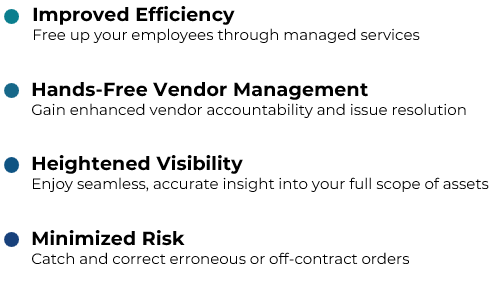Telecom Order Management does more than place orders. It gives your company a streamlined system where visibility drives control, automation fuels efficiency, and accuracy builds confidence.
Why Telecom Order Management Streamlines Your Procurement Process
Telecom is the backbone many businesses but managing it can feel like navigating a labyrinth. Every new service ordered—whether it’s a wireline circuit, PRI, or bandwidth upgrade—adds complexity to procurement teams. Without a streamlined process, the result is delays, inaccuracies, and wasted resources.
That’s where Telecom Order Management changes the game. By moving away from fragmented, manual processes and toward an automated, centralized system, organizations transform order chaos into clarity.
How Manual Orders Drag You Down
Procurement leaders and telecom asset managers know the story too well:
- Multiple vendors, each with their own processes
- Spreadsheets tracking order status—often inaccurate
- Inventory records lagging weeks (or months) behind installations
- Teams wasting hours chasing order confirmations and updates
This inefficiency doesn’t just slow down operations. It creates inaccurate telecom lifecycle management, leading to cost leakage, compliance issues, and missed opportunities to optimize spend.
Break Past Inefficiency with Order Management in Telecom
An order management system for telecom centralizes and automates procurement workflows, creating visibility and control at every step. By using telecom expense management tools built for order tracking, organizations gain:
Automatic Inventory Updates
- Services are added to your inventory the moment they’re confirmed and installed with no manual follow-up required.
End-to-End Order Tracking
- Requests are submitted and monitored through a single dashboard, with reporting that provides real-time insights into every order’s status.
Seamless Vendor Coordination
- The platform connects procurement teams with carriers directly, reducing errors, back-and-forth delays, and confusion.
Streamlined Workflows
- The entire wireline ordering process is managed—from submission to installation—so your employees don’t have to carry the burden.
Why Telecom Order Management?
Even with the right platform, telecom procurement can overwhelm already-busy IT and procurement teams. That’s why organizations turn to Telecom Order Services. By leveraging order management, businesses gain:
- Efficiency: Automation speeds up submission and tracking, removing manual steps and freeing teams for higher-value work.
- Accuracy: The system updates inventory in real time, ensuring records match reality and eliminating costly errors.
- Scalability: As your telecom environment expands, your order management process scales with it

In short, managed services ensure telecom procurement strategy aligns with business strategy.
Telecom Order Management as a Strategic Advantage
Order management isn’t just an operational task. Done right, it becomes a cornerstone of your telecom lifecycle management strategy:
- Procurement teams gain time back to focus on vendor negotiations and cost optimization.
- Asset managers ensure compliance and accurate reporting for audits.
- Executives gain visibility into spend, enabling smarter IT cost decisions.
The days of chasing order numbers and reconciling outdated spreadsheets are over. With Telecom Order Management, you gain clarity, efficiency, and accuracy. All while reducing risk and optimizing the entire telecom lifecycle.
Streamlined Order Systems Fuel Efficiency
In your company where technology moves fast, your telecom procurement process can’t afford to lag behind. Telecom Order Management does more than place orders. It gives your company a streamlined system where visibility drives control, automation fuels efficiency, and accuracy builds confidence.
Ready to take control of your Technology Estate?
Book a demo today and see how you can optimize your global technology management.
Calero | Technology Business Management Solutions Optimize costs, inventory, and operations for SaaS, mobility, telecom, and beyond with a single unified technology business management platform.


